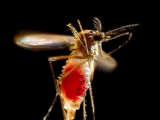Sep 29, 2008 (CIDRAP News) Some public health officials have feared that one of the many miseries of rising home foreclosureand the neglected water sources that followcould be rising rates of human West Nile virus infections, and now California researchers who studied surveillance data for the Bakersfield area have confirmed the connection.
The authors base their conclusion on events that have occurred in Kern County, Calif., where home mortgage delinquencies have increased 300% and the number of human West Nile virus cases exploded 276% during the summer of 2007. Their findings appear in November's early online edition of Emerging Infectious Diseases.
The dramatic rise in laboratory-confirmed human cases ran counter to what surveillance data suggested, they wrote. The area had experienced a dry winter and spring, Culex tarsalis mosquitoesa primary rural vector of West Nile viruspopulations remained below a 5-year average, and the Kern River was mostly dry. Though the drought shrunk bird populations, survivors in key species had high herd immunity to West Nile virus.
However, they found that the infection incidence in Culex pipiens quinquefasciatus mosquitoes, a more common urban vector, increased rapidly a month earlier than expected. Infection in young birds that had little protective immunity was followed by a cluster of human cases in Kern County.
An aerial investigation by the Kern Mosquito and Vector Control District showed several green or neglected pools, most of which were found to be harboring mosquitoes. The authors wrote that swimming pools, hot tubs, and ornamental ponds turn green when chemicals deteriorate, creating algae blooms and a habitat for urban mosquitoes. The authors point out that a photograph that accompanies their report shows that about 17% of visible pools and hot tubs appear green and are probably producing mosquitoes.
Legally, swimming pool areas must be surrounded by 2-meter-high fences and be secured with locked gates, which make it difficult for mosquito-control workers to identify, monitor, and treat neglected pools. Public health officials have asked neighbors to help identify and report pools at abandoned homes, the authors wrote.
After reviewing mosquito surveillance for 2008 so far, the authors noted what they called an alarming trend: many of the pools that housed urban mosquito species are now occupied by the rural Culex tarsalis species, which they say is a more competent West Nile virus vector.
They wrote that historically it's not uncommon for landscape changes to contribute to pathogen outbreaks that are magnified by urban mosquito species and the birds the insects feed on.
Though California is the first area of the country to show a connection between home foreclosures and a spike in human West Nile virus cases, public health officials in other parts of the country are worried about their areas, as well. Health officials in Nassau County, New York, are investigating a spike in West Nile virus cases in the central part of the county, according to a Sep 18 Newsday report.
David Pimentel, professor of entomology at Cornell University in Ithaca, told Newsday that he didn't doubt the connection between the two factors. "The problem is going to occur where you have stagnant water, and that's what you're going to find around foreclosed homes, unattended for months at a time," he said.
The county sprayed an aerial pesticide over a broad section of central Nassau County, the report said.
Maria Torroella Carney, county health commissioner, said her department was evaluating a possible connection between foreclosures and a rise in West Nile virus infections, but she said she needed more data, Newsday reported.
Elsewhere, public health workers in Maricopa County, Ariz., are attempting to prevent West Nile virus outbreaks by putting mosquito-eating minnows in stagnant pools of abandoned homes, according to a Jun 12 report from Reuters. Home foreclosures in the county, which includes Phoenix and the surrounding area, rose threefold in the first 3 months of 2008, the report said.
John Townsend, Maricopa County's vector control manager, told Reuters that his department plans to breed 40,000 of the minnows in tanks at the Phoenix Zoo. "It is an important public health issue to keep the mosquito population down, and the fish are very effective at that," he said.
Daniel Anderson, a city official in Chandler, told Reuters that chlorine levels fall within a few days and pools require frequent treatment. However, using minnows to curb mosquito populations is an appealing nontoxic, low-maintenance tactic. "Once these fish are in the pool, we are not concerned about mosquitoes until someone either buys the house or the pool dries up," he said.
Reisen WK, Takahashi RM, Carroll, et al. Delinquent mortgages, neglected swimming pools, and West Nile virus, California. Emerg Infect Dis 2008 Nov; early online publication [Full text]




















